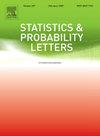Cochran-Mantel-Haeszel多优势比分层校正检验
IF 0.7
4区 数学
Q3 STATISTICS & PROBABILITY
引用次数: 0
摘要
Cochran-Mantel-Haeszel试验(即CMH试验)通常用于检测暴露于危险因素是否对临床结果有显著影响。然而,医学研究中的研究往往需要同时识别几个重要的危险因素。在文献中,一个普遍存在的方法,强有力地控制多个测试的家庭误差率是霍尔姆的逐步下降程序。它在每一步都优雅地应用了一级Bonferroni不等式来做出推理决策。另一方面,当待检验假设的数量很大时,Holm的程序不可避免地继承了Bonferroni不等式的保守性,这使得它在处理大量人口时几乎无用。在本文中,我们提出了一个顺序拒绝程序的同时推理的优势比。我们证明,当测试多个比值比时,新程序一致比霍尔姆程序更强大。仿真研究表明,在某些情况下,改进是实质性的。本文章由计算机程序翻译,如有差异,请以英文原文为准。
Cochran–Mantel–Haeszel stratified-adjusted test for multiple odds ratios
The Cochran–Mantel–Haeszel test (thereby CMH test) is commonly applied to test whether exposure to a risk factor has significant impact on the clinical outcome. However, studies in medical research often require the identification of several significant risk factors simultaneously. In the literature, one of the ubiquitous approaches that strongly control the familywise error rate for multiple tests is the Holm’s step-down procedure. It elegantly applies the first-degree Bonferroni inequality at each step to make inference decisions. On the other hand, when the number of to-be-tested hypotheses is large, Holm’s procedure unavoidably inherits the conservativeness of the Bonferroni inequality, which makes it almost useless when dealing with large number of populations. In this paper, we propose a sequentially rejective procedure for simultaneous inference on odds ratios. We prove that, when testing multiple odds ratios, the new procedure is uniformly more powerful than the Holm’s procedure. Simulation studies show that the improvement is substantial in some scenarios.
求助全文
通过发布文献求助,成功后即可免费获取论文全文。
去求助
来源期刊

Statistics & Probability Letters
数学-统计学与概率论
CiteScore
1.60
自引率
0.00%
发文量
173
审稿时长
6 months
期刊介绍:
Statistics & Probability Letters adopts a novel and highly innovative approach to the publication of research findings in statistics and probability. It features concise articles, rapid publication and broad coverage of the statistics and probability literature.
Statistics & Probability Letters is a refereed journal. Articles will be limited to six journal pages (13 double-space typed pages) including references and figures. Apart from the six-page limitation, originality, quality and clarity will be the criteria for choosing the material to be published in Statistics & Probability Letters. Every attempt will be made to provide the first review of a submitted manuscript within three months of submission.
The proliferation of literature and long publication delays have made it difficult for researchers and practitioners to keep up with new developments outside of, or even within, their specialization. The aim of Statistics & Probability Letters is to help to alleviate this problem. Concise communications (letters) allow readers to quickly and easily digest large amounts of material and to stay up-to-date with developments in all areas of statistics and probability.
The mainstream of Letters will focus on new statistical methods, theoretical results, and innovative applications of statistics and probability to other scientific disciplines. Key results and central ideas must be presented in a clear and concise manner. These results may be part of a larger study that the author will submit at a later time as a full length paper to SPL or to another journal. Theory and methodology may be published with proofs omitted, or only sketched, but only if sufficient support material is provided so that the findings can be verified. Empirical and computational results that are of significant value will be published.
 求助内容:
求助内容: 应助结果提醒方式:
应助结果提醒方式:


